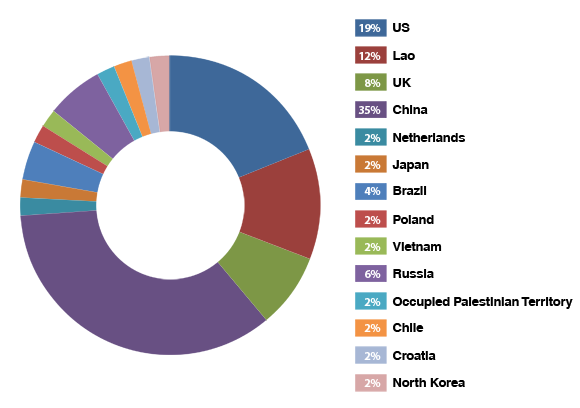Who Is Really Attacking Your ICS Devices?
Industrial Control System (ICS)/SCADA systems have been the talk of the security community for the last three or more years due to Stuxnet, Duqu, and other similar noteworthy attacks. While the importance and lack of security around ICS systems are well documented and widely known, I’ve been researching Internet-facing ICS/SCADA systems, who’s really attacking them, and why. Recently, I spoke at BlackHat Europe about the same research and wrote a research paper to share my findings.
Without knowing if Internet-facing SCADA systems were attacked, I developed a honeypot architecture that would emulate several types of SCADA and ICS devices mimicking those commonly found on these systems. The honeypots included traditional vulnerabilities found across the same or similar systems, showcasing a very realistic honeypot environment.
The findings include real-world attacks from several countries with varying attack attempts.

Figure 1. Percentage of attacks per country
In addition to the statistics gathered about the source of attacking country, my research includes some specific vulnerabilities that threat actors attempted to exploit. Included in some of the attacks I found were an attempt to spearphish a site administrator and a bid to exploit fundamental ICS protocols.
Our expectation is that attack trends will continue to increase in the ICS arena, with possible far reaching consequences. With continued diligence and utilizing secure computing techniques, your ability to deflect and defend these attacks will help secure your organization. For more information about these findings, you may read my report “Who’s Really Attacking Your ICS Equipment?” and find out details of some of these attacks and who are some primary offenders.
Like it? Add this infographic to your site:
1. Click on the box below. 2. Press Ctrl+A to select all. 3. Press Ctrl+C to copy. 4. Paste the code into your page (Ctrl+V).
Image will appear the same size as you see above.
Recent Posts
- Estimating Future Risk Outbreaks at Scale in Real-World Deployments
- The Next Phase of Cybercrime: Agentic AI and the Shift to Autonomous Criminal Operations
- Reimagining Fraud Operations: The Rise of AI-Powered Scam Assembly Lines
- The Devil Reviews Xanthorox: A Criminal-Focused Analysis of the Latest Malicious LLM Offering
- AI Security Starts Here: The Essentials for Every Organization

 Complexity and Visibility Gaps in Power Automate
Complexity and Visibility Gaps in Power Automate AI Security Starts Here: The Essentials for Every Organization
AI Security Starts Here: The Essentials for Every Organization The AI-fication of Cyberthreats: Trend Micro Security Predictions for 2026
The AI-fication of Cyberthreats: Trend Micro Security Predictions for 2026 Stay Ahead of AI Threats: Secure LLM Applications With Trend Vision One
Stay Ahead of AI Threats: Secure LLM Applications With Trend Vision One